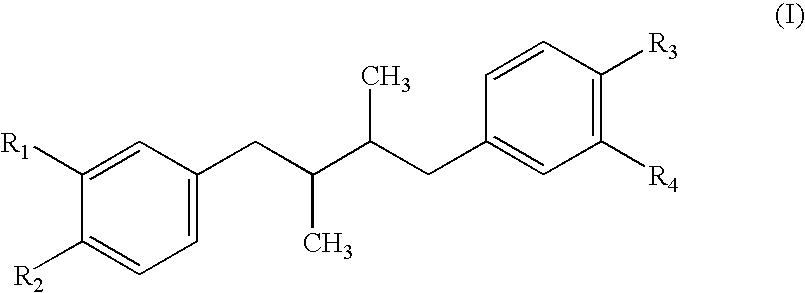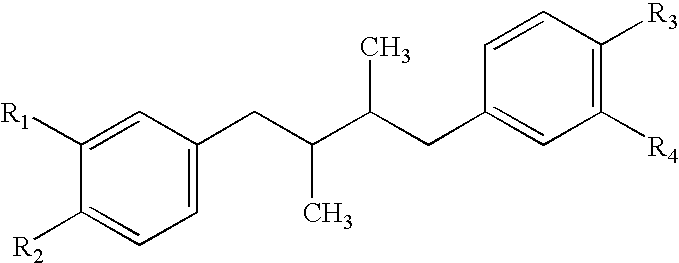Method for treatment of tumors using nordihydroguaiaretic acid derivatives
a technology of nordihydroguaiaretic acid and derivatives, which is applied in the direction of heterocyclic compound active ingredients, biocide, drug compositions, etc., can solve the problems of increasing the rate of apoptosis and cell death, labor-intensive and costly isolation and purification of plant lignans, and limiting their use to the lowest effective concentration, so as to reduce the dosage effect of drug, suppress growth, and avoid whole body toxicity
- Summary
- Abstract
- Description
- Claims
- Application Information
AI Technical Summary
Benefits of technology
Problems solved by technology
Method used
Image
Examples
example 2
[0065] Example 2
[0066] Inhibition of E.sub.6 / E.sub.7 mRNA synthesis following M.sub.4N treatment
[0067] Inhibition of E.sub.6 / E.sub.7 mRNA synthesis following M.sub.4N treatment was measured by RT-PCR in cervical cell line C.sub.3.multidot.Relative RT-PCR was performed with quantities of total cellular RNA standardized to the cell numbers counted. The RT-PCR product was analyzed on a 2% agarose gel. The results are shown in FIG. 3. The RT-PCR results indicated that the amplified cDNAs of the expected size for E7 (321 bp) and E6 (204 bp) were detected in the DMSO treated cells as early as cycle 22 of amplification. These same products were barely detectable in the drug treated RNA extracts following 30 cycles of amplification. No amplified products were detected for the no template PCR control or from total RNA extracts of the HPV16-negative C33a cell line.
example 3
[0068] Example 3
[0069] Inhibition of cervical C3 cell growth by M.sub.4N treatment
[0070] HPV-16 transformed immortal mouse epithelial cells (C3 cells) were plated at a density of 10.sup.5 cells per vial. After 24 hours, 1 / 2 of the vials were given growth media containing 40 .mu.M M.sub.4N dissolved in 1% DMSO while the other half were given growth media containing only 1% DMSO. The results are shown in FIG. 4A. Within 24 hrs a difference in cell morphology between drug treated and control C3 cells was observed. The growth and division of the drug treated cells was markedly reduced in comparison to the untreated control, while the fraction of viable cells compared to the total cell count remained constant for both drug treated and DMSO only control cells. This indicates that M.sub.4N dramatically reduces cell division.
[0071] The effect on C3 growth following removal of M.sub.4N from the medium was also examined. C3 cells were plated at a density of 10.sup.4 cells per vial. At time=0,...
example 4
[0072] Example 4
[0073] Analysis of cellular gene expression in C3 cells before and after 72 hrs of drug treatment.
[0074] Gene expression with 9600 gene arrays was studied (FIG. 5). Five micrograms each of poly A.sup.+ RNA from 72 hrs. M.sub.4N (40 .mu.m) treated (C.sub.3M.sub.4N) and non-treated (C.sub.3 DMSO) was used in a pair of human 9600 gene array hybridization study according to the procedure described in Genomics 51, 313-324 1998. The hybridization image was captured by a color video camera with a Nikon 55 mm AF micro Niko lens and digitized by a Macintosh LC630 computer. Such detection via enzyme substrate reaction of color-forming enzymes in either single or dual-color mode is reproducible and extremely sensitive (can detect <5 copies of transcript per cell with RNAs from 10.sup.7 cells).
[0075] The computer print outs showing differentially expressed genes (C.sub.3M.sub.4N / C.sub.3 DMSO >10 and C.sub.3DMSO / C.sub.3M.sub.4N>1-0) were listed for examination. Image files in TIF...
PUM
| Property | Measurement | Unit |
|---|---|---|
| weight | aaaaa | aaaaa |
| concentration | aaaaa | aaaaa |
| volume | aaaaa | aaaaa |
Abstract
Description
Claims
Application Information
 Login to View More
Login to View More - R&D
- Intellectual Property
- Life Sciences
- Materials
- Tech Scout
- Unparalleled Data Quality
- Higher Quality Content
- 60% Fewer Hallucinations
Browse by: Latest US Patents, China's latest patents, Technical Efficacy Thesaurus, Application Domain, Technology Topic, Popular Technical Reports.
© 2025 PatSnap. All rights reserved.Legal|Privacy policy|Modern Slavery Act Transparency Statement|Sitemap|About US| Contact US: help@patsnap.com



